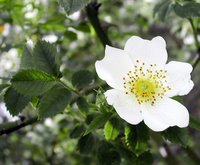Rosaceae
|
|
| Rosaceae | ||||||||||
|---|---|---|---|---|---|---|---|---|---|---|
 Rosa arvensis | ||||||||||
| Scientific classification | ||||||||||
| ||||||||||
| Subfamilies | ||||||||||
|
Rosoideae |
The Rosaceae or rose family is a large family of plants, with about 3,000-4,000 species in 100-120 genera. Traditionally it has been divided into 4 subfamilies (Rosoideae, Spiraeoideae, Maloideae or Pomoideae, and Amygdaloideae or Prunoideae), primarily diagnosed by the structure of the fruits, but this has not been universally followed. Recent work has identified that the traditional four subfamilies are not all monophyletic, but the structure of the family is still awaiting complete resolution. Identified clades include:
- Subfamily Rosoideae: Traditionally composed of those genera bearing small fruits, each of which is an achene or drupelet, and often the fleshy part of the fruit (e.g. strawberry) is the hypanthium or the stalk bearing the carpels. The circumscription is now narrowed (excluding, for example, the tribe Dryadeae), but it still remains a diverse group containing 5 or 6 tribes and 20 or more genera. Rose, blackberry, raspberry, strawberry, Potentilla, Geum.
- Subfamily Spiraeoideae: Traditionally those genera which bear non-fleshy fruits consisting of five capsules. Now perhaps to be restricted to Spiraea and Sorbaria and their respective allies.
- Subfamily Maloideae: Traditionally this includes the genera (apple, cotoneaster, hawthorn, pear, quince, rowan, whitebeam, etc), whose fruits consist of five capsules (called "cores") in a fleshy endocarp, surrounded by the ripened stem tissue. This structure is called a pome (after the French name for an apple, pomme). To these are added the woody genera Lindleya and Vauquelinia, which share a haploid chromosome count of 17 (x=17) with the pomiferous genera, Kageneckia, in which x=15, and the herbaceous genus Gillenia (x=9), which is the sibling to the remaining maloids.
- Subfamily Amygdaloideae (or Prunoideae): Traditionally those genera whose fruits consist of a single drupe with a seam, two veins next to the seam, and one vein opposite the seam. Now extended to include the five genera Exochorda, Maddenia, Oemleria, Prinsepia and Prunus (plum, peach, almond, cherry, apricot).
- Tribe Dryadeae: Fruits are achenes with hairy styles. Includes five genera (Dryas, Cercocarpus, Chamaebatia, Cowania and Purshia), most species of which form root nodules which host the nitrogen-fixing bacterium Frankia.
- Tribe Neillieae: Neillia (including Stephanandra) and Physocarpus.
Amongst these groups Neillieae appears to be the sibling group to Maloideae, and Dryadeae may be the sibling group to Rosoideae. Other genera, for example Kerria, do not belong to any of these groups.
A tongue-in-cheek poem
- The rose is a rose
and was always a rose;
But the theory now goes
That the apple's a rose,
And the pear is, and so's
The plum, I suppose.
The dear only knows
What will next prove a rose.
You, my love, are a rose,
but were always a rose.- - Robert Frost, "The Rose Family".
- The rose is a rose
External link
- University of Illinois - Rosaceae (http://www.life.uiuc.edu/plantbio/260/Rosaceae/Rosehome.html)da:Rosen-familien (Rosaceae)
de:Rosengewächse es:Rosaceae fr:Rosaceae ja:バラ科 lt:ErÅ¡kÄtiniai_augalai nl:Rozenfamilie no:Rosefamilien pt:Rosaceae sv:Rosväxter wa:Rôzacêye zh:蔷薇科
